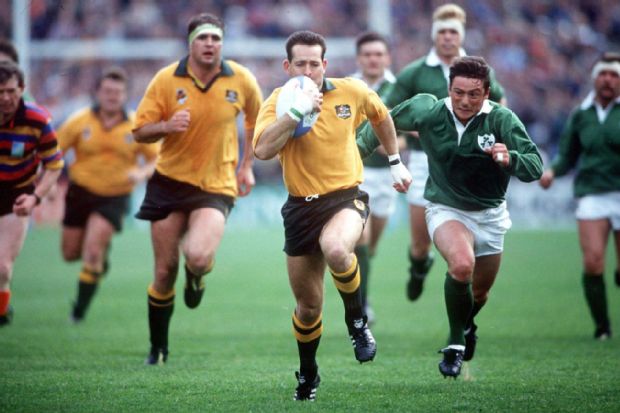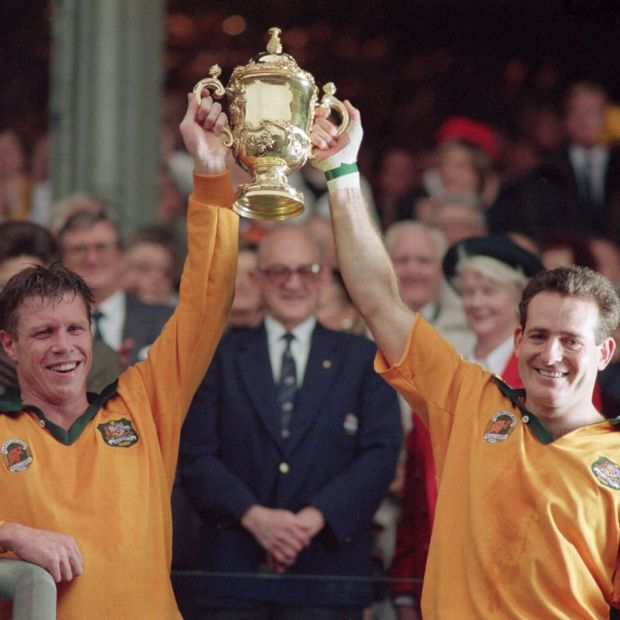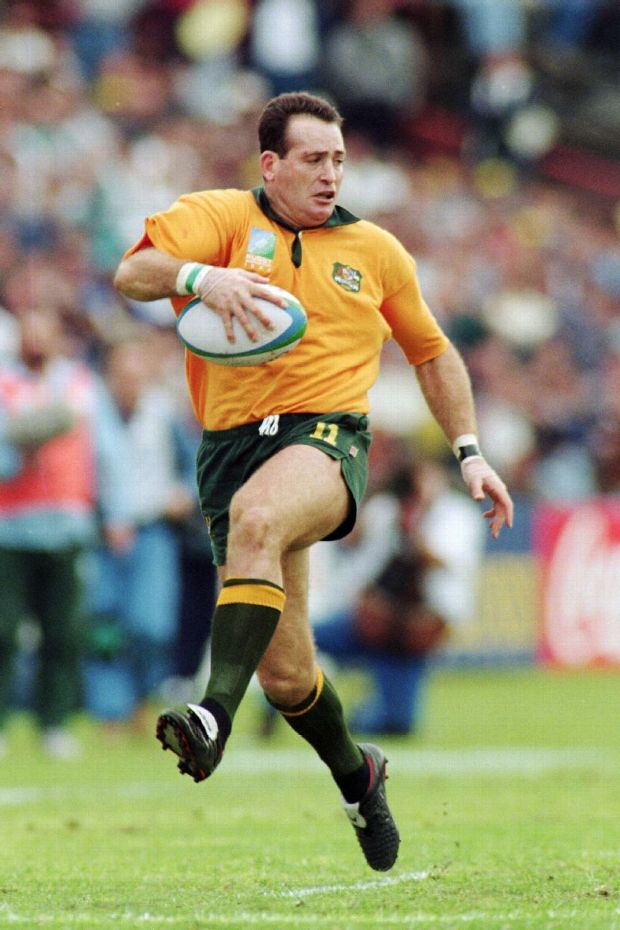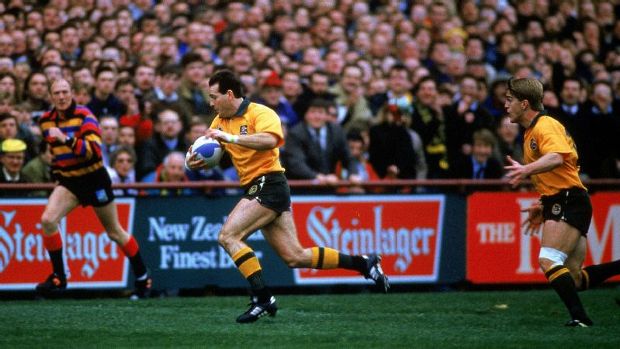|
Rugby World Cup
David Campese transformed rugby into art at 1991 Rugby World Cup
Greg Growden
September 14, 2015
 David Campese lit up the 1991 Rugby World Cup© Bob Thomas / Getty Images The many, many moods of David Campese. I have witnessed them all. He can be ebullient. He can be deeply depressed, bewildered with the world. He can often feel that what has happened to him is unjust. He can be all embracing. He can be so selfless. He can even be selfish. He can be acidic. He often talks before thinking. And when he does think, what he says can sting even more. He can be so disillusioned. He can be on top of everything. He can be a ratbag. He can exasperate. He can infuriate. He often delights. He likes to be at the core of the activity. He can be a loner. He is a marvelous family man; a proud father, an all-embracing husband. How he feels constantly changes. No matter what, he is one of the very few to completely transform a World Cup tournament, and be a defining factor in a country taking the title. Having known Campese for well over 30 years, there are countless memories. The most vivid revolve around the 1991 World Cup. By the time of that tournament I had already experienced the many jolts and screams that is the emotional roller-coaster ride which goes with being close to Campese.  Nick Farr-Jones (left) and winger David Campese lift the Webb Ellis Cup© Russell Cheyne/Getty Images My first lengthy experience with Campese came during the 1986 Wallabies tour of New Zealand, where for a great deal of the time he was an emotional wreck - struggling with his form and disillusioned that his coach, Alan Jones, had appeared to lose faith in him. His confidence was shot. Luckily Mark Ella was there to pull Campese together between matches. Onto 1988, when at Cardiff Arms Park we were witness to a moment of Campese wizardry, and where he discovered exactly what the rugby aficionado thought of him. It was the final match of the tour: Australia v Barbarians. The match was about over when Campese went a bit crazy. He went every which way on his way to the try line. There were steps, swivels and swerves. Gavin Hastings, Jonathan Davies and countless others were helpless in trying to stop him. As he returned to centre-field, the rest of the Australian team stood to attention and clapped him back to his wing spot. High above in the terraces, the fans left their seats to make the Campese tribute echo to almost thunderous proportions. ESPN is proud to announce an exclusive 1-hour special - Cheika's Wallabies: Hope of a Nation - with a repeat broadcast on ESPN Thu Sept 17 at 9pm AEST (9pm NZ). ESPNscrum's leading rugby expert Greg Growden goes one-on-one with the Wallabies coach in this exclusive special that gives a rare insight into the intriguing personality of Australia's head coach. Campese was bemused by all this attention, deciding to clap them back in appreciation of their fine gesture, the most rousing since the Cardiff crowd sang For He's A Jolly Good Fellow to All Blacks captain Wilson Whineray at the end of the 1964 Barbarians match. After that 1988 match, four spectators ran onto the Arms Park with a sign that proclaimed: 'Dave Campese Walks on Water'. He was again on top of the world. Not for long. The 1989 British & Irish Lions effectively clipped his wings. In the third Test, a misdirected pass from Campese to fullback Greg Martin led to the easiest of Lions tries and the winger being widely condemned. His fellow players abused him. The media attacked him. A disenchanted, lonely, emotional figure was sighted leaving the dressing room about 15 minutes after full-time, head bowed, walking slowly towards the ground exit. For six months, Campese and the Australian media were involved in a big freeze. He would see us, and flee. He felt that we had turned him into a walking, talking fool. There was intense fury on both sides. The relationship began to thaw only at the 1991 World Cup when Campese had no option but to again embrace the press, because he was actually the main story. This emanated from the most extraordinary of weeks in Dublin, where in two matches and two spectacular performances Campese guided Australia to their first and most important of World Cup triumphs.  David Campese ... the goosestep became an iconic image in world rugby© Mike Hewitt /Allsport First that quarter-final against Ireland, when acting captain Michael Lynagh was so delighted that for a change Campese actually listened to him, took heed of his instructions and stuck to the basics of a move that got the Wallabies out of the mire. The game was nearly over. Ireland had somehow taken the lead. Lynagh was acting captain. He drew the players together behind the Dublin-end goalposts at Lansdowne Road and slowly explained his escape route. Lynagh and Campese at that time had a pretty fragile relationship. They had taken potshots at each other. So Lynagh wasn't exactly certain if Campese would follow his plan. But as Lynagh explained in his recent book Blindsided - the best way of managing Campese was to "make him feel that he was involved in team decision making". After some misdirected kicking from both sides, a lineout was set inside the Irish quarter. Lynagh explained: "Campo came back inside and was caught. Campo held onto the ball and stayed in the ruck, always going towards the opposition goal line. So for once Campo was listening. He held onto possession, we got the drive forward, we won the feed to the scrum, so we now had the opportunity to organise the backline move. We had done this move four or five times before, including earlier in the game, and I had always finished in the same spot, but never received the ball for various reasons. The one time I needed to get the ball, and scoop it up off the ground, it happened. I scored." The move involved a cutout pass from Tim Horan to Marty Roebuck, with Jason Little looping around and darting in next to Roebuck's right shoulder, before offloading to Campese. It was assumed that Campese would score. But he was tackled, while his task was made even more difficult after Little had been obstructed. Campese somehow tossed the ball up in the tackle to Lynagh, who found space amid the confusion of legs and arms to score just inside the corner flag. The great escape.
A week on we were all back at Lansdowne Road for more Campese conjuring. First that run. That audacious run. In the first half of the semi-final against New Zealand, Campese ignored the first command of backline play of running straight, by speeding across the field at a strange 45-degree angle. It was a taunt that worked. Although he had a wall of New Zealand defenders in front of him, none knew what to do. No-one wanted to take Campese on, believing they could be set up by a scissors pass or a cut back inside. Instead they held off him, with the ultimate embarrassment being that Campese, still on the same 45-degree run, stood up John Kirwan to score. That then pass. That audacious pass. Just before half-time, the play went to the other side of the field. Lynagh, realising the New Zealand defence was extremely flat, chipped the ball behind the winger. This gave Campese enough room to retrieve the ball, just in front of New Zealand fullback Kieran Crowley. Campese was off, darting either way on several occasions, before he appeared to be blotted out by the New Zealand defence. Then came a moment of inexplicable mental telepathy. Tim Horan was on his left, but then decided to curl around his winger. Campese had only a faint idea of where Horan was, but at the ideal moment hurled the ball over his right shoulder into his centre's arms, who then crossed for a try. Thus was born the famous Campo Hail Mary Try.  David Campese set up Tim Horan against New Zealand© Mike Hewitt /Allsport© Getty Images A week later Australia were celebrating a World Cup triumph - with Campese, the man of the tournament, in his rightful spot standing next to captain Nick Farr-Jones when they were both presented with the Webb Ellis Trophy by The Queen. The mood between the Campese and the media had eased. There were a few testing moments in the coming years, especially when Campese was part of a breakaway group that threatened to take over the shamateur rugby ranks. But the respect intensified on both sides. With age came a sense of maturity. Sure, the crazy statements occasionally appeared, but Campese gradually got it - and learned how to use the media; sometimes even to his own advantage. And he respected those who stuck by him during the tough times. Our relationship has had its numerous hiccups, at its lowest after the Lions bungle, but gradually it became very, very tight. We have been close for several decades. We probably just wore each other down - to the extent now it revolves around who is better at ridiculing the other. Once a vehement critic has become a close comrade. It does happen. The point is that Campese is often misunderstood. That has a lot to do with his sometimes overly direct approach. He can appear abrasive, when he actually isn't trying to be. It's just his manner. By stating what he thinks, he believes he is helping the individual. But the message can sometimes be unnecessarily blunt, and the message can sometimes be lost. He often doesn't realise he is the master of burnt bridges. Most importantly, he chose his life partner very, very well. His wife, Lara, who when first meeting him had no idea of his sporting prowess, has succeeded in softening him. So have his three children. No matter what you think about Campo the man, and he has tickled up quite a few over the decades, you can never downgrade his immense value to Australian rugby. At his peak, there was simply no one better to watch transforming rugby into a different art form. If still in doubt, just wind back the tape and study the 1991 World Cup all over again.  David Campese acknowledges the crowd after playing his final international© Clive Brusnkill/Allsport © Greg Growden
|
Live Sports
Communication error please reload the page.
-
Football
-
Cricket
-
Rugby
-
- Days
- Hrs
- Mins
- Secs
F1 - Abu Dhabi GP
Abu Dhabi Grand Prix December 11-131. Max Verstappen ()
2. Valtteri Bottas (Mercedes)
3. Lewis Hamilton (Mercedes)
4. Alexander Albon ()
5. Lando Norris ()
6. Carlos Sainz Jr ()
-
ESPNOtherLive >>
Snooker - China Open
Tennis - Miami Open


